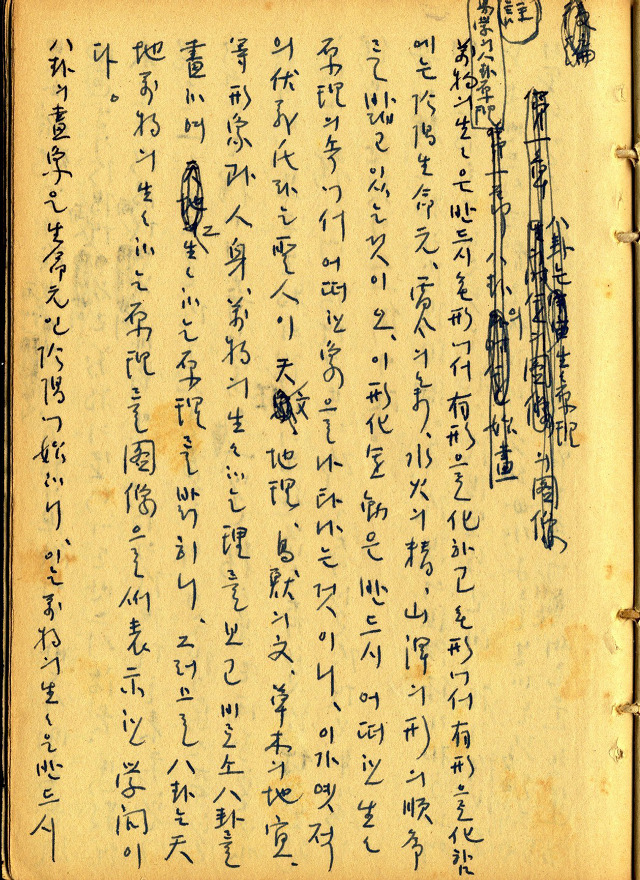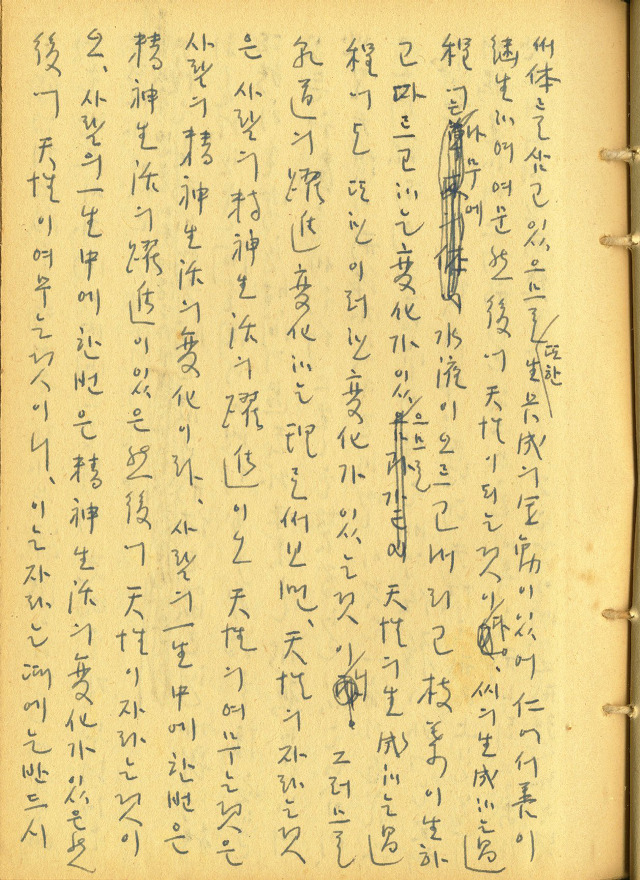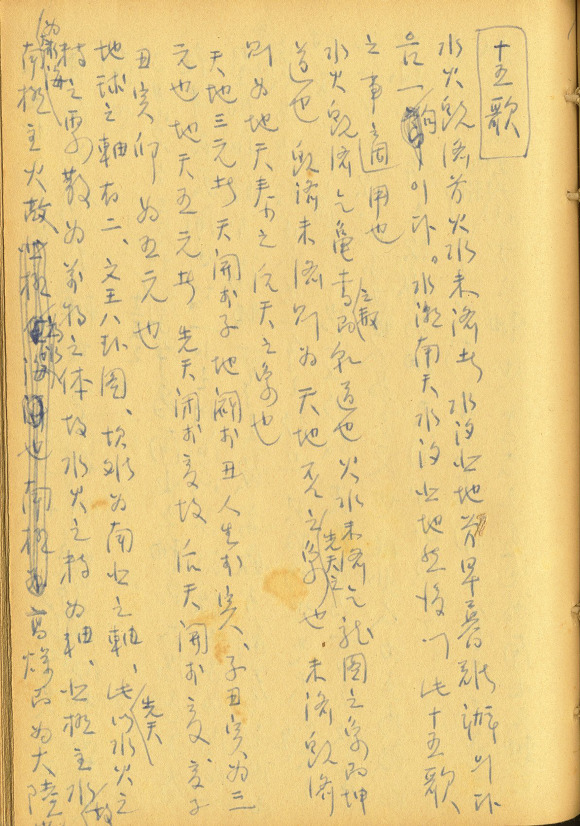本文主要是介绍易學原論 韓長庚,希望对大家解决编程问题提供一定的参考价值,需要的开发者们随着小编来一起学习吧!
<目 次>
第一章 총론(總論)
第一節 상(象)과 법칙(法則)
‣천지(天地)는 한 태일체(太一體) http://skyyoon.tistory.com/229
‣상(象)과 자연법칙(自然法則)과의 관계(關係) http://skyyoon.tistory.com/228
‣사회(社會)와 생존법칙(生存法則) http://skyyoon.tistory.com/227
‣천지(天地)와 일월(日月)은 만상(萬象)의 대종(大宗) http://skyyoon.tistory.com/226
‣역리(易理)와 정치(政治) http://skyyoon.tistory.com/225
第二節 조직(組織)과 운행(運行)
‣천지(天地)와 일월(日月)의 작용(作用) http://skyyoon.tistory.com/224
‣조직(組織)의 음양성(陰陽性) http://skyyoon.tistory.com/223
‣운행(運行)의 사시성(四時性) http://skyyoon.tistory.com/222
‣조직(組織)∙운행(運行)의 계통(系統) http://skyyoon.tistory.com/221
第二章 대대원리(對待原理)
第一節 통일(統一)과 대대(對待)
‣일이이(一而二) 이이일(二而一)의 작용(作用) http://yoonsangki.tistory.com/97
‣유물론(唯物論)과 유심론(唯心論) http://yoonsangki.tistory.com/96
‣대대(對待)의 분포(分布) http://yoonsangki.tistory.com/95
‣통관(通觀)과 동관(童觀) http://yoonsangki.tistory.com/94
第二節 대대(對待)와 운동(運動)
‣대대(對待)의 호근(互根) http://skyyoon.tistory.com/216
‣대대(對待)의 균등(均등(等)) http://skyyoon.tistory.com/215
‣사회(社會)의 신진대사(新陳代謝) http://skyyoon.tistory.com/214
第三節 대대(對待)와 삼재(三才)
‣대대조직(對待組織)과 삼재운행(三才運行) http://skyyoon.tistory.com/213
‣삼색(三索)과 삼극(三極) http://skyyoon.tistory.com/212
‣능동(能動)과 수동(受動) http://skyyoon.tistory.com/211
‣개체(個體)와 통체(統體) http://skyyoon.tistory.com/210
‣안정(安貞)과 발용(發用) http://skyyoon.tistory.com/209
‣삼대용(三對用)의 착종(錯綜) http://skyyoon.tistory.com/208
第三章 대시(大始)와 정(情)
第一節 삼정(三情)(삼본능(三本能))
‣본능(本能)은 생존작용(生存作用)의 발단(發端) http://skyyoon.tistory.com/207
‣본능(本能)과 선악문제(善惡問題) http://skyyoon.tistory.com/206
‣선악(善惡)과 미추(美醜) http://skyyoon.tistory.com/205
‣악(惡)의 발생(發生)하는 까닭 http://skyyoon.tistory.com/204
第二節 感應
‣감응(感應)은 괴위중(乖違中)의 상교(相交) http://skyyoon.tistory.com/203
‣일음일양(一陰一陽)의 상배(相配) http://skyyoon.tistory.com/202
‣이간(易簡)의 이(理) http://skyyoon.tistory.com/201
第三節 萃聚
‣췌취(萃聚)는 분산중(分散中)의 통합(統合) http://skyyoon.tistory.com/200
‣점지진(漸之進)의 리(理) http://skyyoon.tistory.com/199
‣식물(食物)과 학문(學問)의 췌취(萃聚) http://skyyoon.tistory.com/198
‣권세(權勢)와 재화(財貨)의 췌취(萃聚) http://skyyoon.tistory.com/197
第四節 항구(恒久)
‣항구(恒久)는 변화중(變化中)의 불변(不變) http://skyyoon.tistory.com/196
‣진화론(進化論)과의 관계(關係) http://skyyoon.tistory.com/195
‣항구(恒久)는 생존(生存)의 기초(基礎) http://skyyoon.tistory.com/194
第五節 삼정(三情)과 사정(四情)
‣정대본능(正大本能) http://skyyoon.tistory.com/193
‣사람과 동식(動植)과의 비교(比較) http://skyyoon.tistory.com/192
‣삼정(三情)과 생활(生活)과의 관계(關係) http://skyyoon.tistory.com/191
‣정치(政治)의 삼정작용(三情作用) http://skyyoon.tistory.com/190
第四章 유형(流形)과 시용(時用)
第一節 삼시용(三時用)과 사시의(四時義)
‣상반(相反)의 속에 상제(相濟)가 있다 http://skyyoon.tistory.com/189
‣규이(睽異)의 시용(時用) http://skyyoon.tistory.com/188
‣함험(陷險)의 시용(時用) http://skyyoon.tistory.com/187
‣건난(蹇難)의 시용(時用) http://skyyoon.tistory.com/186
‣시용(時用)과 시의(時義) http://skyyoon.tistory.com/185
第二節 차등(差등(等))과 균평(均平)
‣호대호소(互大互小)의 원리(原理) http://skyyoon.tistory.com/184
‣현대(現代) 정치사상(政治思想)의 발원(發源) http://skyyoon.tistory.com/183
‣사회(社會)의 균평운동(均平運動) http://skyyoon.tistory.com/182
第三節 투쟁(鬪爭)과 조화(調和)
‣조화(調和)를 얻기 위(爲)한 투쟁(鬪爭) http://skyyoon.tistory.com/181
‣투쟁(鬪爭)과 조화(調和)의 반복(反復) http://skyyoon.tistory.com/180
‣악(惡)의 극제(克制)가 곧 투쟁(鬪爭)이다 http://skyyoon.tistory.com/179
‣지도자(指導者)의 시범(示範) http://skyyoon.tistory.com/178
第四節 안정(安定)과 유동(流動)
‣안정(安定)은 방(方)하고 유동(流動)은 원(圓)하다 http://skyyoon.tistory.com/177
‣방(方)과 원(圓)의 호근(互根) http://skyyoon.tistory.com/176
‣환주운동(圜周運動)과 직선운동(直線運動) http://skyyoon.tistory.com/175
‣자전(自轉)과 공전(公轉) http://skyyoon.tistory.com/174
第五章 변화(變化)와 역(易)
第一節 삼역(三易)
‣궁변통구(窮變通久) http://skyyoon.tistory.com/173
‣삼역(三易)의 혼륜(渾淪) http://skyyoon.tistory.com/172
第二節 변역(變易)
‣소장운동(消長運動) http://skyyoon.tistory.com/171
‣보수(保守)와 혁신(革新) http://skyyoon.tistory.com/170
‣양극(兩極)과 중간(中間) http://skyyoon.tistory.com/169
第三節 교역(交易)
‣정위적(定位的) 질서(秩序)와 교체적(交體的) 질서(秩序) http://skyyoon.tistory.com/124
‣권력(權力)과 도덕(道德) http://skyyoon.tistory.com/123
第四節 반역(反易)
‣만물(萬物)은 모두 반생(反生) http://skyyoon.tistory.com/122
‣신(新)이란 무엇인가 http://skyyoon.tistory.com/121
‣성반제(成反齊)의 이(理) http://skyyoon.tistory.com/120
第六章 대화(大和)와 중(中)
第一節 중(中)과 절(節)
‣대대(對待)․ 중심(中心)․ 통일(統一) http://skyyoon.tistory.com/119
‣태극(太極)이란 무엇인가 http://skyyoon.tistory.com/118
‣한도(限度)와 절(節) http://skyyoon.tistory.com/53
‣삼현일장(三顯一藏)의 이(理) http://skyyoon.tistory.com/52
第二節 중(中)과 화(和)
‣화(和)는 중운동(中運動)의 극치(極致) http://skyyoon.tistory.com/51
‣이간(易簡)의 우로(憂勞) http://skyyoon.tistory.com/50
‣전례(典禮)와 경건(敬虔) http://skyyoon.tistory.com/49
‣언사(言辭)와 풍악(風樂) http://skyyoon.tistory.com/48
‣예악(禮樂)의 근본정신(根本精神) http://skyyoon.tistory.com/47
第七章 운명(運命)과 자유의지(自由意志)
‣운명(運命)은 선천(先天)이오 자유의지(自由意志)는 후천(後天)이다 http://skyyoon.tistory.com/46
‣천명(天命)과 운명(運命)과의 관계(關係) http://skyyoon.tistory.com/45
‣관상학(觀相學)의 원리(原理) http://skyyoon.tistory.com/44
‣선천(先天)과 후천(後天)의 교호작용(交互作用) http://skyyoon.tistory.com/43
第八章 결론(結論)
‣사람의 생존(生存)하는 목적(目的) http://skyyoon.tistory.com/42
‣본능(本能)은 생존목적(生存目的)을 달성(達成)하는 수단(手段) http://skyyoon.tistory.com/41
‣무한(無限)한 즐거움 http://skyyoon.tistory.com/40
‣즐거움도 만인만색(萬人萬色) http://skyyoon.tistory.com/38
‣근심과 즐거움 http://skyyoon.tistory.com/38
【附錄 一】
역학(易學)과 우리 국문(國文)과의 관계(關係)
‣제자원리(制字原理) http://skyyoon.tistory.com/37
‣초성(初聲)은 사시(四時)의 이(理) 초성(初聲)은 십칠자(十七字) http://skyyoon.tistory.com/37
‣中聲은 三才의 理 中聲은 十一字 http://skyyoon.tistory.com/37
‣초(初)와 종(終)의 순환(循環) http://skyyoon.tistory.com/37
‣만성(萬聲)의 생생(生生) http://skyyoon.tistory.com/37
【附錄 二】
역학(易學)으로 본 귀신문제(鬼神問題)
‣귀신(鬼神)의 유무(有無) http://skyyoon.tistory.com/36
‣사람의 생사(生死)와 귀신(鬼神) http://skyyoon.tistory.com/35
‣신(神)․인(人)․동(動)․식(植) 의 사등류(四등(等)類) http://skyyoon.tistory.com/35
‣귀신(鬼神)의 이(理)와 정치(政治) http://skyyoon.tistory.com/33
【附錄 三】
역학(易學)으로 본 수(數)와 상(象)과의 관계(關係)
‣수(數)와 상(象) http://skyyoon.tistory.com/31
‣하도(河圖)와 낙서(洛書) http://skyyoon.tistory.com/30
‣구륙(九六)과 칠팔(七八) http://skyyoon.tistory.com/29
‣구륙칠팔(九六七八)은 생명(生命)의 호흡(呼吸) http://skyyoon.tistory.com/28
【附錄 四】
역학(易學)으로 본 시운(時運)의 변천(變遷)
‣하도(河圖)와 낙서(洛書)는 시운(時運)의 상징(象徵) http://skyyoon.tistory.com/5
‣생존작용(生存作用)의 생(生)․장(長)․성(成) http://skyyoon.tistory.com/4
‣삼도(三圖)와 시운(時運)의 상(象) http://skyyoon.tistory.com/3
‣지금은 인류역사(人類歷史)의 전환기(轉換期) http://skyyoon.tistory.com/2
‣대운중(大運中)의 소운(小運)과 지역(地域)의 기운(氣運) http://skyyoon.tistory.com/1
这篇关于易學原論 韓長庚的文章就介绍到这儿,希望我们推荐的文章对编程师们有所帮助!










